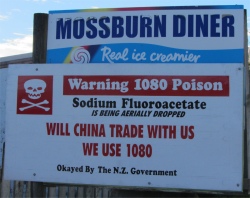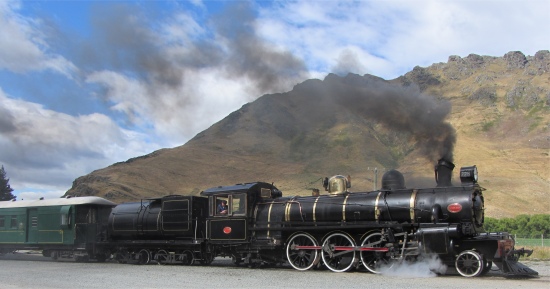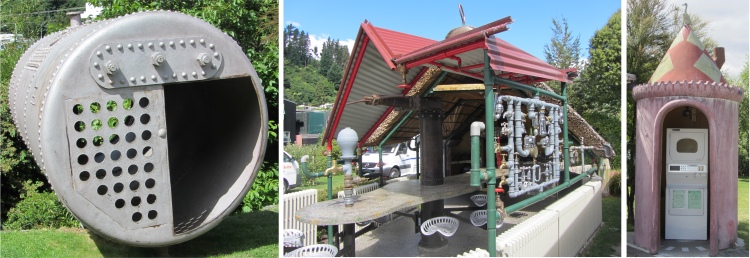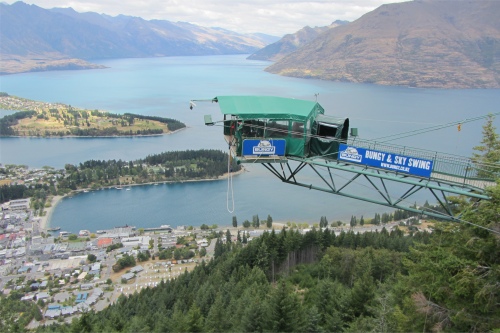Fifty years passed before Queenstown started to enjoy a new lease of life. It was now known for its commerce-oriented tourism, especially adventure and ski tourism, and overflowed with young international and New Zealand travellers. Queenstown, also known as Screamstown, didn't earn its title of "Adventure Capital of the World" for nothing. Here, you could bungy jump, ski or snowboard, paraglide, jet boat, white water raft, skydive, hang glide, jetski, and drive quadbikes to your heart's content; an adrenaline junkies paradise - almost as good as Bognar.
Locating the campsite recommended was quite easy. Jackie, on the reception, had moved to Queenstown eight years ago, and was now married to a Kiwi. She had never looked back since. Whereas the Manapouri campsite was full of vintage vehicles, this site was full of creative designs made out of small to large plumbing systems. I learned that Tony, the owner, had been a plumber who had also worked on large pipe systems for hydro plants too. He had a creative streak in him, and hence the quirky campsite. My pitch had a very large painted boiler sitting next to it.
Also next to the boiler were a couple who lived in Poole, owned a second home in Woodbridge (near where I live), and also owned another home in Cypress. The lady was born and bred in Ipswich, and liked to return to visit her siblings, hence the reason for buying property in the area. Travelling was one of the couple's passions, cruising was the other, both on crusie ships and on yachts.
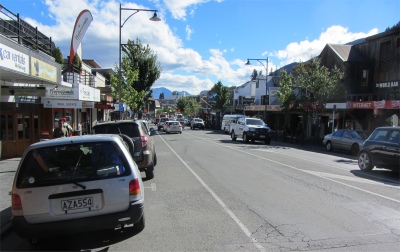
Downtown Queenstown
|
To get an overview of the area, I took the Skyline Gondola up to Bob's Peak, which rose up from behind the town. The cable car soared up 450m to a complex from where I was treated to stupendous views of Queenstown and Lake Wakatipu below me, and the encircling Remarkables, plus Cecil and Walter Peaks. The glorious scenery surrounding me had provided the background for many feature films, including
The Lion, The Witch and the Wardrobe, Willow, The Rescue, X-Men Origins: Wolverine, The Vertical Limit, plus provided the highest concentration of locations for
The Lord of the Rings trilogy.
On the pine-clad brow of the hill, a cleared area provided an ideal launch site for paragliders, and nearby there was the inevitable bungy jump and swing. First thoughts on activity holidays in New Zealand would include bungy jumping, especially in Queenstown, the bungy capital of the world. I have skydived, paraglided, participated in extreme canyoning, white water rafted, etc., etc., but never bungy jumped, and I didn't intend to either. To me, it seemed a little daft. Our bodies are designed to tolerate compressive forces, and the stretching jolt experienced during bungy jumping was anything but. In addition, there have been reports of people's retinas becoming detached through bungy jumping. On these grounds, even though my motto has always been try anything at least once, I will forego bungy jumping. To get my adrenaline kick, I took the luge from the crest of Bob's Peak back down to the top Gondola complex. This involved negotiating a twisting concrete track on a small wheeled buggy with the most primitive of braking systems; good fun though.
The busy town beckoned me, and it is very much a tourist hub with every space crammed with businesses only too eager to take your money. I needed to top up my adrenaline reserves, so I enrolled for a 4-wheel drive trip up Skippers Canyon with a Jetboat ride for the following morning. Then it was a case of casually strolling around the town, blending in with all the other tourists.
For my culture kick I popped into a few art galleries, and there was one that grabbed my attention. It featured several large landscapes of Fiordland scenes, plus one seascape. The detail and finish on these was astounding. I stood for a while in front of the seascape trying to analyse how the artist had achieved the luminosity of the work. A woman associated with the gallery came across. "How did the artist achieve that, what's his technique?" I asked rather cheekily. "He paints in layers," she answered. "Ah, like Leonardo da Vinci," I replied. Her ears pricked up and she gave me a curious glance asking, "Are you an artist?" "No, but I have been known to dabble," I replied. She explained to me how the artist had travelled extensively throughout Europe to study the techniques of the grand masters such as da Vinci and Vermeer, hence his heavy use of layer painting.
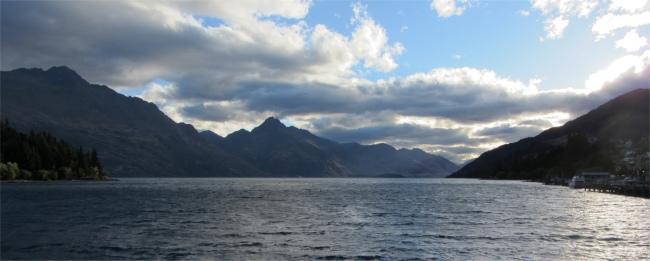
Looking up Lake Wakatupi to Walters Peak
|
"Does he complete a series of sketches on the spot and then rework them back in the studio?" was my next question. "No, he works entirely from memory," was the reply. She saw I had difficulty with that response, so she said, "Why don't you ask him, he is sitting over there."
Tim Wilson was sitting on a stool, and he readily shook my hand as I introduced myself. He was self-taught, and had been painting for 50 years or so since he was seven years old. he had grown up in Palmerston North, and spent many years in Auckland before moving down here to open the gallery. He knew Britain well, and had painted in the Lake District and East Anglia during his European travels. He did indeed paint in layers, which was how he achieved the luminosity and the finish he wanted. He was tackling more seascapes nowadays since he relished the challenge they posed. It was excellent being able to chat to the artist of work being viewed, and he took my details so that he could email me the final images of work in progress. A kind man.
Towards the end of play I had a beer in a bar, and got talking to two guys next to me whose accent was almost incomprehensible. I could be forgiven, they were well under the influence and most of their speech was slurred. It turned out they were from Dublin, and had lived here for two years, working as block-layers. "You block pave drives or pavements?" I asked. "No, we lay blocks. See here on my shirt - Queenstown Blocklayers," he said pointing to the logo on his T-shirt. It took a wee while to translate this into brick layers, but they used blocks instead of bricks. I thought at one point the guy was going to take a swing at me for my ignorance. The bigger of the two, who must have weighed 18-stone, leaned on me after a while for support; how am I going to get rid of this bear I wondered. He then drained some lethal cocktail in one swig, gave me a big hug, and staggered outside for a cigarette. Time for a quick escape I said to myself.
